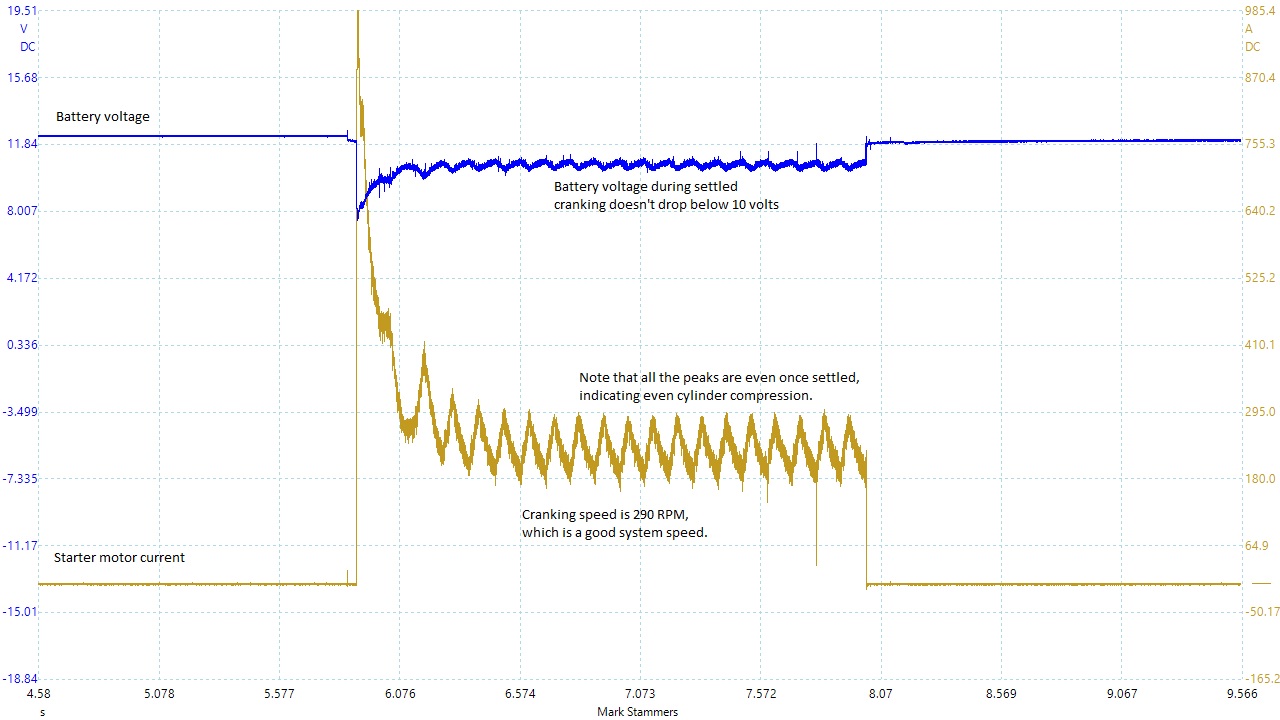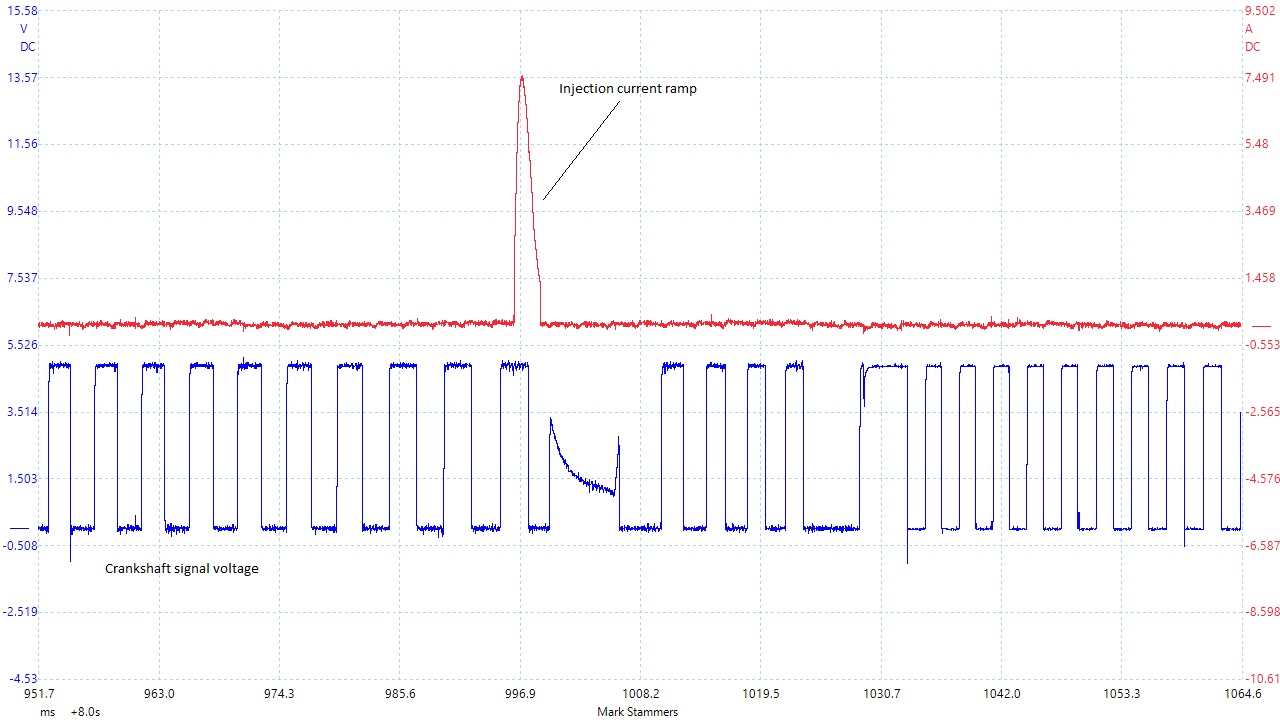Jeep Compass 2.0L PD Diesel (Engine code ECD / BYL) non start.
This vehicle was recovered to the garage, after breaking down whilst driving.
There were no DTC’s recorded and the engine would crank for a very short period, stop and crank again. This symptom was similar to when a battery has a bad cell, but a bad cell doesn’t usually cause failure during drive. The battery was tested and was found to be good.
So I wanted to see if there was maybe a starter motor issue, again not likely to be connected with the reported drive failure, but sometimes information is distorted.
I carried out a starter motor performance analysis, by directly energising the solenoid. As you can see in the waveform, the starter current and battery voltage performed okay.

Because the starter operation was good, I had to think about why it may keep cutting out during normal key operation. I was thinking that the ECM was making the decision to inhibit the starter operation. So I used serial data analysis and noticed there was no engine rpm given. This is not always reliable as a test, but I thought it worth checking, as maybe a strategy could include ‘stop cranking if no RPM signal is received’. So I went about scoping the crankshaft sensor. As this is a Jeep, getting a wiring diagram proves a little difficult, however the engine is a VAG PD engine similar to that of a VW Golf and I was able to cross reference it with a suitable circuit diagram, although the wire colours seemed to be different.
The crankshaft sensor is not very accessible on this engine and so I tried to pick up the wire for the signal in the harness. As I couldn’t recognise the wire colour I used my milliamps clamp to find the signal as this would not disturb or damage any wiring. Straight away I could confirm there was a crankshaft signal present, but I could see an anomaly with the current during the cranking test. The current level was not stable. I was unsure about the validity of this test, as the current clamp can be a little sensitive, so I pierced the wire for a voltage sample. Luckily I picked the right wire first go. (A little repair after the test will fix the damage). This verified the voltage level, which I had been concerned about, but showed me a drop-out in the signal which corresponded at a compression stroke, as noted by the starter current that fortunately I was still measuring. The current clamp signal could not easily display this anomaly, which is why you do really need to see voltage.

I then added in another channel and re-scoped, now capturing the engine ground. As can be seen in the waveform, the ground isn’t great, but it doesn’t show any relationship to the anomaly.

As I inspected the crankshaft signal, I realised the drop-out was cyclic, but not every crankshaft revolution, so it can’t be a reluctor ring fault. Although not seen in my samples here, during my tests very often the drop-out would occur every other crankshaft revolution, this made me think of camshaft related events, along with the realisation that the event occurred at a compression stroke, I figured there was a fault with an injector. So I disconnected the injector harness main connector and then found I could crank the engine and the crankshaft signal drop-out was gone. At last! It must be a faulty injector shorting out.

So I had the engine top cover removed, so that I could check which injector it was. To my surprise, I couldn’t fault any of them. I tried disconnecting one in-turn and trying to start the engine. The same symptom was present. I even disconnected all but one, and still no joy!
I scoped the current to the injectors and confirmed the fault occurred with an injection phase and, in fact the current signal did not look correct as is shown below.

Now, although I didn’t have a known good injector pattern to hand, I did recognise that the pattern I had from this vehicle was wrong. Because removing the load from the ECM, allowed it to operate correctly, I had to assume the fault must be to do with the ECM or it’s power supply and ground. I had the security cage removed, so that I might access the connectors and conduct my tests. I started by sampling the main ground at the control module, and found that to be ok, then I checked the main power supply and this showed a problem.

So this proved the fault appeared to be caused by a power supply issue. I managed to find the main relay and tested its input and output voltage. It behaved perfectly. Now I was struggling to locate the fuse after the relay and before the ECM. I managed to contact my friendly data provider and they tracked down the necessary pin out data and fuse location. From this I was able to determine a high resistance between the fuse and the ECM. A bit of stripping, resulted in the discovery of a corroded portion of wiring on the circuit. A quick snip and the replacement of a section of wire and we were back in action.

So in conclusion, the current required to drive an injector proved too much load for the corroded power supply and consequently disrupted the crankshaft signal, along with many other sensors I expect. Of course you may have spotted a problem with the cyclic nature of the drop-out. It appears to not be every injection event and I do not have an explanation of that, except it probably depends on how much load the damaged wire could handle at a given time.
With all these things, it would be nice to analyse every aspect of the condition, but the real world requires fix it as quickly as possible and move on….